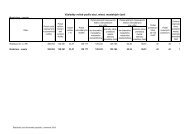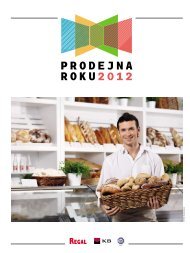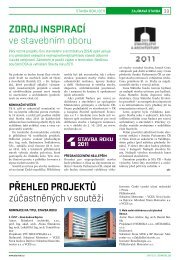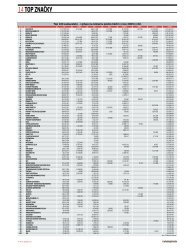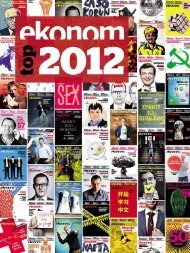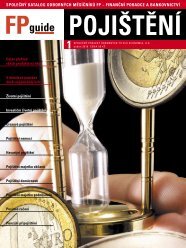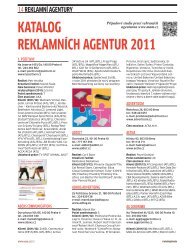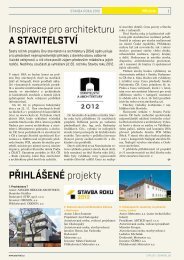ALL TOGETHER NOW - iHNed
ALL TOGETHER NOW - iHNed
ALL TOGETHER NOW - iHNed
You also want an ePaper? Increase the reach of your titles
YUMPU automatically turns print PDFs into web optimized ePapers that Google loves.
■ CAREERS MULTIGENERATIONAL WORKPLACES<strong>ALL</strong> <strong>TOGETHER</strong> <strong>NOW</strong>Mnoho generací vjedné firmě: jak dostat pracovníky různých věkových skupin pod jednu střechu tak,aby byli všichni spokojeni? Informuje MARGARET DAVIS.mediumIt’s nine o’clock on Monday morning, time for theweekly project meeting in Joe’soffice. Joe, the greyhairedproject leader, has aphoto of his two childrenon his desk. The kids are parents themselvesnow, but the photo shows them as laughing toddlers.Marjorie has brought her laptop to the meetingso she can take the minutes. Beth has brought apen,paper —and cake. She is followed by Marty,the intern,who is listening to his iPod and reading text messageson his mobile phone.Welcome to the modern workplace, where severalgenerations meet, interact and communicate —sometimesmore effectively than others. So, who’swho in thisgroup?■ Joe, 65, is afew months away from retirement. Heis amember of the Veteran Generation (also knownas “traditionalists”), born before 1946. This groupbelieves in hard work, loyalty and dependability.■ Beth, 55, is a baby boomer, part of the generationborn between 1946 and 1964. Baby boomers grewup in good economic times and are used to seeingtheir demands met. They make up nearly 60 percent of today’s labour market.■ Marjorie, 41, is a Generation Xer, one of the groupborn between 1964 and 1981. Their job history hasbeen marked by recessions in the early 1980s and1990s. This made it difficult for them to find permanentjobs, so they changed frequently,and manystarted their own businesses.■ Marty, the 22-year-old intern, is a Gen Yer (alsoknown as a“millennial” or a“nexus”), amemberof the generation born after 1980. This group iscomfortable working with new technology. Theyhave been strongly affected by what they saw happeningto their parents in the difficult job market ofthe 1990s.All four have characteristics typical of their group. Joehas been with the company for more than 20 years. Aloyal employee, he has worked hard to reach apositionof responsibility, and he doesn’t like change, as shownby the photo of his children on his desk. Beth is not soaverse to change butprefers pen and paper to high-techgadgets,and she likes the personal touch of face-to-facemeetings. Marjorie embraces technology, but haschanged jobs frequently and is ready to leave at shortnotice if something better comes along. Marty is just outof university and has grown up with new technology.He thinks meetings are awaste of time —couldn’t thishave been done by email? —but is clever enough tokeep his opinions to himself.Clichés? Ofcourse. No group corresponds exactlyto these descriptions, but recognizing their existencemay help you to understand and work more compatiblywith your colleagues. And if you are amanager orsupervisor, finding the right method of communicatingwith each group can reduce conflicts and misunderstandings.Canadian Linda Duxbury (see interview on page 52),aprofessor at the Sprott School of Business at CarletonUniversity in Ottawa, compares the job market to abus.The seats on the bus are the jobs. “The people born between1946 and 1958 have the good seats on the bus,the early boomers. Their seats are so good they don’tappreciate what it’s like on the rest of the bus,”Duxbury told Carleton University Magazine. Bythetime Generation Xreached the bus stop, all the seatswere taken and they were forced to stand. “These peopledidn’t get good jobs. Alot of those people bornthroughout the 1960s have been on and off anumberof buses just to go home.”Meanwhile, the bus is falling apart: there is litter onthe floor,and the seats are dirty and torn.Nothing is beingdone about it, because the bus company doesn’tseethe necessity: people keep using the bus. “There wereaffected: be ~bysth.[E(fektId]appreciate sth. [E(pri:SieIt]averse: be ~tosth. [E(v§:s]cliché [(kli:SeI]dependability [di)pendE(bIlEti]embrace sth. [Im(breIs]face-to-face [)feIs tE (feIs]gadget [(gÄdZIt]intern [(Int§:n] N. Am.litter [(lItE]short notice: at ~ [)SO:t (nEUtIs]supervisor [(su:pEvaIzE]take the minutes[)teIk DE (mInIts]text message [(tekst )mesIdZ]toddler [(tQdlE]torn [tO:n]touch [tVtS]být ovlivněn čímuvědomovat sistavět se odmítavě kčemu[kvůli výslovnosti]spolehlivostpřijmout (rád)osobní, vpřímém kontaktuzařízenístážista, praktikantodpadnarychlo,během krátké dobynadřízenýpořídit zápiszpráva SMSbatolepotrhanýkouzlo, nádech50 Business Spotlight5/2010
Thinkstock“The job market is likeabus, andthe baby boomers gotthe best seats”




